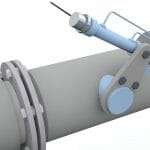A specialist manufacturer of fire resistant clothing that offers its customers exceptional protection in both hot and cold environments is keen to draw comparisons between inherent and treated fabrics and ensure that engineers are aware of how to tell the difference between the two.
Skanwear provides high-quality and long-lasting garments that offer exceptional protection against the often fatal implications of arc flash, which can be characterized as an electrical explosion caused by high temperatures and extreme pressures.
Inherent garments offer exceptional protection that can never be worn or washed away. These products are composed of fibers that are innately flame resistant, meaning that they do not have to undergo any type of process to ensure that they offer substantial protection.
Inherent garments are made with a blend of fibres including one or more fibres that are permanently flame retardant through the physical nature of the fibre. The most common inherent fibres in ARC Flash clothing are Modacrylic and Aramid, with Protex Modacrylic being the most popular brand name of Modacrylic.
These fibres are often then blended with other fibres to create different end applications, these other fibres are often; FR Viscose, Cotton, Nylon, Polyamide, Polyester or Para-aramid. Once these fibres are blended the fabric will always remain Flame Retardant regardless of washing.
Treated garments are made with a blend of fibres where traditionally Cotton is the most predominant fibre. This is sometimes just 100% Cotton, or as low as 65% Cotton. This cotton is then blended with other fibres such as Polyester or Nylon. Because Cotton is not a Flame Retardant fibre it has to have a Flame Retardant treatment to give the fabric the Flame Retardant properties. There are many brands of Flame Retardant treatment but they are all treated in a similar way.
Woven or knitted fabrics are always dyed to corporate colours such as Navy Blue or Hi-Vis Yellow etc. The Flame Retardant finish is applied in the same way, by being “washed” into the fabric or fibre. Because the treatment is washed in, it is also susceptible to being washed just like a pair of Jeans or a Cotton Shirt that fades over time. Over time the treatment fades and the protection will diminish.
Angus Long, Global Technical Manager said: “When it comes to choosing PPE, engineers and managers need to be made aware of the differences between inherent and treated fabrics, as this will help them to make the best choice for their environment.
“One of the easiest ways for companies and individuals to distinguish between the two when they are choosing garments is to simply look at what the description says. Our website offers detailed descriptions and includes information about both the composition and standards of garments.
“The actual structure of clothing that is made of inherent fabric is not flammable, therefore meaning that the flame trait is permanent. In contrast to this, treated fabrics are made by applying a flame-retardant chemical finish to a fabric or by adding a chemical treatment to the fibers before they are woven or knitted into the fabric.”
Inherent fabrics consistently have a higher Thermal Protective Performance (TPP) rating than treated fabrics, meaning that generally they will provide engineers with much more robust protection.
This ARC Global Hi-Viz Jacket (CL.1/ARC 2) is made of lightweight Inherent fabric and comes with adjustable cuffs and internal pockets.
For more information about SKANWEAR and their product range, visit their website at: www.skanwear.com






